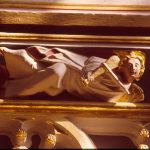 In the four years that I served as a steward and tour guide at Exeter Cathedral, there were some interesting curiosities I encountered. Many are old, such as the cat hole in the door leading to the clock mechanism in the north transept that allowed a cathedral cat to hunt the mice that liked to eat the ropes of the clock mechanism. Yet, this curiosity is not old enough to have been in place at the time of Plague of a Green Man, my second Lady Apollonia West Country Mystery, set in Exeter in 1380. The hole was installed in the time of Bishop Cotton, 1598-1621, too late for Lady Apollonia’s period.
In the four years that I served as a steward and tour guide at Exeter Cathedral, there were some interesting curiosities I encountered. Many are old, such as the cat hole in the door leading to the clock mechanism in the north transept that allowed a cathedral cat to hunt the mice that liked to eat the ropes of the clock mechanism. Yet, this curiosity is not old enough to have been in place at the time of Plague of a Green Man, my second Lady Apollonia West Country Mystery, set in Exeter in 1380. The hole was installed in the time of Bishop Cotton, 1598-1621, too late for Lady Apollonia’s period.
So, let me describe some curiosities which already existed in the cathedral in 1380. One is the dog-whipper’s flat which is directly over the north porch and behind the Minstrels’ Gallery, a feature of the cathedral that I described earlier this year in my blog post of September 9. The flat was literally a residence for the staff member called the dog-whipper, complete with cooking facilities and a garderobe or medieval toilet. From this elevated position, the dog-whipper could watch things going on inside the nave and spot any feral dogs who might be loose inside the church. He had a stave or strong wooden pole that he could use in chasing dogs out of the church. That stave is now in the possession of the cathedral’s head verger.
The flat has not been occupied since the 19th century, but vestiges of its cooking facilities and garderobe still exist and its space is largely used in our time for storage. The most well used thing found in the space just behind the Minstrels’ Gallery in modern times is a set of cathedral organ pipes for very high notes. Most of Exeter’s organ pipes are in the giant organ cabinet above the screen separating the quire from the nave. Some very large pipes for bass notes are in the south transept in addition to those in the dog-whipper’s flat.
A different curiosity is found between the Lady Chapel and Saint Gabriel’s Chapel. I found it on the tomb of Bishop Walter Bronescombe who died in 1280 after starting the rebuilding of the Gothic church we see today. The canopy and base below the effigy were added to his tomb in the 15th century, but the effigy and the 14th century version of the tomb were in place at the time of my novel. The curious feature is not the tomb itself but a series of small carved angel musicians that are shown playing a host of medieval instruments including the zither, violin, portative organ, shawm, harp, lute, and bagpipe. These are instruments that are also played by the angel musicians of the Minstrels’ Gallery, but the Bronescombe tomb angels are tiny by comparison and easily missed by a casual viewer. The angel playing the violin is pictured above. All aspects of the tomb would have been brightly painted. Much whitewash and paint has been removed over the centuries to reveal remnants of medieval colours in their surviving glory.
For more on Exeter’s dog-whipper, click on
https://en.wikipedia.org/wiki/Dog_whipper .
Tags: Chaucer's England, historical fiction, medieval mysteries